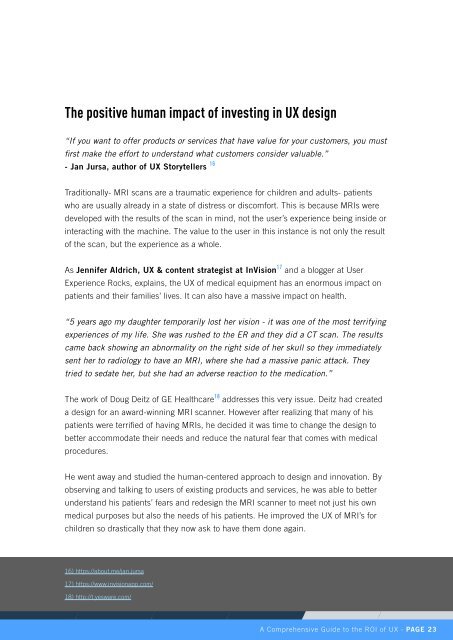The Trillion Dollar UX Problem
2lTlHAS
2lTlHAS
Create successful ePaper yourself
Turn your PDF publications into a flip-book with our unique Google optimized e-Paper software.
<strong>The</strong> positive human impact of investing in <strong>UX</strong> design<br />
“If you want to offer products or services that have value for your customers, you must<br />
first make the effort to understand what customers consider valuable.”<br />
- Jan Jursa, author of <strong>UX</strong> Storytellers 16<br />
Traditionally- MRI scans are a traumatic experience for children and adults- patients<br />
who are usually already in a state of distress or discomfort. This is because MRIs were<br />
developed with the results of the scan in mind, not the user’s experience being inside or<br />
interacting with the machine. <strong>The</strong> value to the user in this instance is not only the result<br />
of the scan, but the experience as a whole.<br />
As Jennifer Aldrich, <strong>UX</strong> & content strategist at InVision 17 and a blogger at User<br />
Experience Rocks, explains, the <strong>UX</strong> of medical equipment has an enormous impact on<br />
patients and their families’ lives. It can also have a massive impact on health.<br />
“5 years ago my daughter temporarily lost her vision - it was one of the most terrifying<br />
experiences of my life. She was rushed to the ER and they did a CT scan. <strong>The</strong> results<br />
came back showing an abnormality on the right side of her skull so they immediately<br />
sent her to radiology to have an MRI, where she had a massive panic attack. <strong>The</strong>y<br />
tried to sedate her, but she had an adverse reaction to the medication.”<br />
<strong>The</strong> work of Doug Deitz of GE Healthcare 18 addresses this very issue. Deitz had created<br />
a design for an award-winning MRI scanner. However after realizing that many of his<br />
patients were terrified of having MRIs, he decided it was time to change the design to<br />
better accommodate their needs and reduce the natural fear that comes with medical<br />
procedures.<br />
He went away and studied the human-centered approach to design and innovation. By<br />
observing and talking to users of existing products and services, he was able to better<br />
understand his patients’ fears and redesign the MRI scanner to meet not just his own<br />
medical purposes but also the needs of his patients. He improved the <strong>UX</strong> of MRI’s for<br />
children so drastically that they now ask to have them done again.<br />
16) https://about.me/jan.jursa<br />
17) https://www.invisionapp.com/<br />
18) http://t.yesware.com/<br />
A Comprehensive Guide to the ROI of <strong>UX</strong> - PAGE 23


